
The Eurofighter Typhoon is a European multinational twin-engine, supersonic, canard delta wing, multirole fighter. The Typhoon was designed originally as an air-superiority fighter and is manufactured by a consortium of Airbus, BAE Systems and Leonardo that conducts the majority of the project through a joint holding company, Eurofighter Jagdflugzeug GmbH. The NATO Eurofighter and Tornado Management Agency, representing the UK, Germany, Italy and Spain, manages the project and is the prime customer.
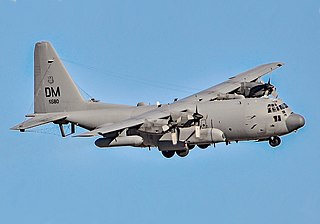
The EC-130H Compass Call is an electronic attack aircraft flown by the United States Air Force. Based on the Lockheed C-130 Hercules, the aircraft is heavily modified to disrupt enemy command and control communications, perform offensive counterinformation operations, and carry out other kinds of electronic attacks. Planned upgrades will add the ability to attack early warning and acquisition radars. Based at Davis-Monthan AFB in Arizona, EC-130Hs can be deployed worldwide at short notice to support U.S. and allied strategic and tactical air, surface, and special operations forces.

The Euroradar Captor is a next-generation mechanical multi-mode pulse Doppler radar designed for the Eurofighter Typhoon. Development of Captor led to the Airborne Multirole Solid State Active Array Radar (AMSAR) project which eventually produced the CAESAR, now known as Captor-E.
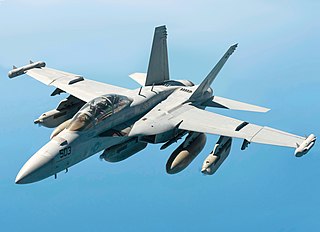
The Boeing EA-18G Growler is an American carrier-based electronic warfare aircraft, a specialized version of the two-seat Boeing F/A-18F Super Hornet. The EA-18G replaced the Northrop Grumman EA-6B Prowlers in service with the United States Navy. The Growler's electronic warfare capability is primarily provided by Northrop Grumman. The EA-18G began production in 2007 and entered operational service with the US Navy in late 2009. Australia has also purchased thirteen EA-18Gs, which entered service with the Royal Australian Air Force in 2017.
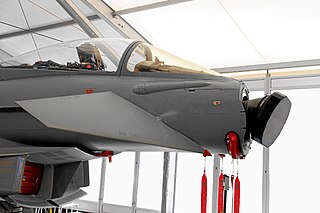
An active electronically scanned array (AESA) is a type of phased-array antenna, which is a computer-controlled antenna array in which the beam of radio waves can be electronically steered to point in different directions without moving the antenna. In the AESA, each antenna element is connected to a small solid-state transmit/receive module (TRM) under the control of a computer, which performs the functions of a transmitter and/or receiver for the antenna. This contrasts with a passive electronically scanned array (PESA), in which all the antenna elements are connected to a single transmitter and/or receiver through phase shifters under the control of the computer. AESA's main use is in radar, and these are known as active phased-array radar (APAR).

The Eurofighter Typhoon is in service with nine nations: United Kingdom, Germany, Italy, Spain, Saudi Arabia, Oman, Qatar, Kuwait, and Austria, with orders for all nine customers still pending as of September 2017. The aircraft has, as of 2016, been provided in a basic air-defense form and has been upgraded to newer production standards which include internal IRST, air-to-ground precision strike capability, and HMSS helmets. Most of the major systems including the CAPTOR radar and the Defence Aids Sub-System (DASS) are expected to be improved and updated over time, with the radar being updated to an AESA, being the CAPTOR-E/CAESAR, of which the Kuwait Air Force will be the inaugural operator, with first deliveries of their 28 new-built aircraft to commence in 2019.

An electronic countermeasure (ECM) is an electrical or electronic device designed to trick or deceive radar, sonar, or other detection systems, like infrared (IR) or lasers. It may be used both offensively and defensively to deny targeting information to an enemy. The system may make many separate targets appear to the enemy, or make the real target appear to disappear or move about randomly. It is used effectively to protect aircraft from guided missiles. Most air forces use ECM to protect their aircraft from attack. It has also been deployed by military ships and recently on some advanced tanks to fool laser/IR guided missiles. It is frequently coupled with stealth advances so that the ECM systems have an easier job. Offensive ECM often takes the form of jamming. Self-protecting (defensive) ECM includes using blip enhancement and jamming of missile terminal homers.

The Common Security and Defence Policy (CSDP) is the European Union's (EU) course of action in the fields of defence and crisis management, and a main component of the EU's Common Foreign and Security Policy (CFSP).
Electronic counter-countermeasures (ECCM) is a part of electronic warfare which includes a variety of practices which attempt to reduce or eliminate the effect of electronic countermeasures (ECM) on electronic sensors aboard vehicles, ships and aircraft and weapons such as missiles. ECCM is also known as electronic protective measures (EPM), chiefly in Europe. In practice, EPM often means resistance to jamming. A more detailed description defines it as the electronic warfare operations taken by a radar to offset the enemy's countermeasure.
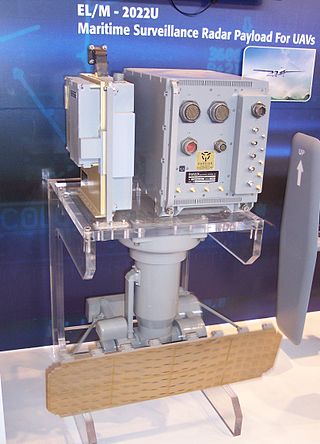
ELTA Systems Ltd (ELTA) is a leading Israeli defense technology company specializing in designing, developing, and producing advanced electronic systems and sensors. A group and subsidiary of the government-owned Israel Aerospace Industries (IAI) offers an extensive product portfolio encompassing Radar, ELINT, COMINT, C4STAR, Electronic Warfare, Communications, Autonomous Ground vehicles and Cyber systems. The company's products are utilized by Defense forces, Homeland Security, and law enforcement organizations utilize the company's products worldwide.
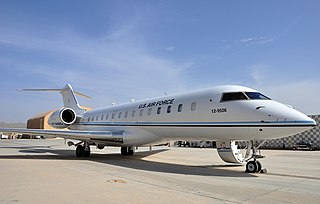
The Battlefield Airborne Communications Node (BACN) is a United States Air Force (USAF) airborne communications relay and gateway system carried by the unmanned EQ-4B and the manned Bombardier E-11A aircraft. BACN enables real-time information flow across the battlespace between similar and dissimilar tactical data link and voice systems through relay, bridging, and data translation in line-of-sight and beyond-line-of-sight situations. Its ability to translate between dissimilar communications systems allows them to interoperate without modification.
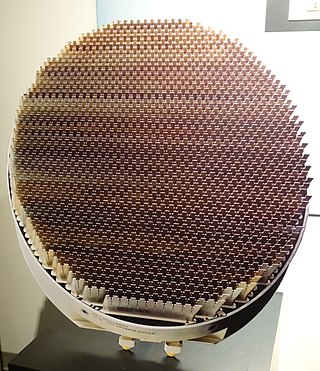
The AN/APG-81 is an active electronically scanned array (AESA) fire-control radar system designed by Northrop Grumman Electronic Systems for the Lockheed Martin F-35 Lightning II.
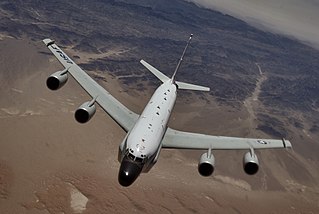
Signals intelligence operational platforms are employed by nations to collect signals intelligence, which is intelligence-gathering by interception of signals, whether between people or between machines, or mixtures of the two. As sensitive information is often encrypted, signals intelligence often involves the use of cryptanalysis. However, traffic analysis—the study of who is signalling whom and in what quantity—can often produce valuable information, even when the messages themselves cannot be decrypted.
The Combat Aircraft Systems Development & Integration Centre (CASDIC) is a laboratory of the Indian Defence Research and Development Organisation (DRDO). Located in Bangalore, Karnataka, India, It is one of the two DRDO laboratories involved in the research and development of airborne electronic warfare and mission avionics systems.

The 42d Electronic Combat Squadron is a United States Air Force unit. Its current assignment is with the 55th Electronic Combat Group at Davis–Monthan Air Force Base, Arizona as a geographically separated unit from its parent wing, the 55th Wing at Offutt Air Force Base, Nebraska. The squadron is the Air Force's sole Lockheed EC-130H Compass Call formal training unit.
The Next Generation Jammer is a program to develop an airborne electronic warfare system, as a replacement for the AN/ALQ-99 found on the EA-18G Growler military aircraft. It reached Initial Operating Capability in 2021.

The Permanent Structured Cooperation (PESCO) is the part of the European Union's (EU) security and defence policy (CSDP) in which 26 of the 27 national armed forces pursue structural integration. Based on Article 42(6) and Protocol 10 of the Treaty on European Union, introduced by the Treaty of Lisbon in 2009, PESCO was initiated in 2017. The integration into PESCO is through projects which launched in 2018.
Sky Shield is an advanced airborne electronic warfare system for fighter jets developed by Rafael Advanced Defense Systems of Israel.

The AN/ALQ-218 is an American airborne electronic warfare radar warning receiver (RWR) system, found on Grumman/Northrop Grumman EA-6B Prowler and Boeing EA-18G Growler aircraft.

The L3Harris EA-37B Compass Call is an electronic warfare aircraft based on the Gulfstream G550 entering service with the United States Air Force with the first example delivered on 23 August 2024 to Davis–Monthan Air Force Base for crew training. The plane is replacing the EC-130H Compass Call.















